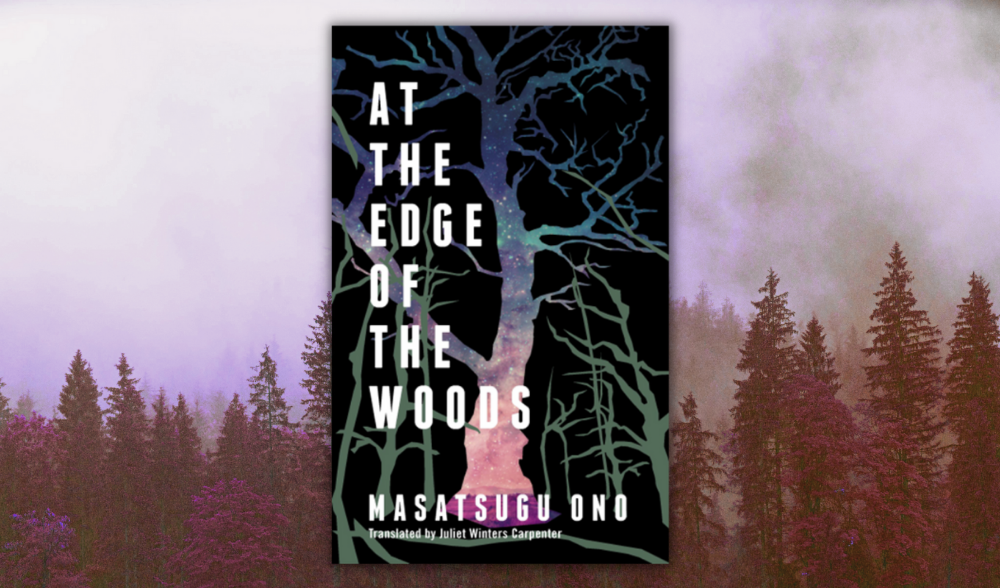BOOK REVIEW EDITOR-IN-CHIEF ELLA KELLEHER WRITES – In an unnamed country, a family of three settles into a creaking house at the edge of an ominous forest. The father cannot help but notice that something is quite off about this place. Are the trees coughing? No… laughing? As so many Japanese legends have it, fantastical creatures live in the depths of the woods where feudal lords of antiquity ruled and resistance fighters were defeated. The carcasses of their once beautiful creations have made wonderful castles for the forest imps and ghouls. When a pregnant mother, who fears her unborn child will be snatched away by an imp, decides to leave and give birth elsewhere, her husband and son are left to their own devices in a home near the rural woods. At the mercy of their unknown environment, the two begin to succumb to paranoia and delusion. At this moment is when this edgy novel about existence and cognition takes off.

The world around the father is alive. The hills breathe like a sleeping child, and the trees whisper secrets to each other. While his son is rapt with curiosity about the woods, his father finds the place utterly mystical and terrifying.
Japanese author Masatsugu Ono, with the help of the long-established, brilliant translator Juliet Winters Carpenter, divides the line of understanding clearly between the father and son – one is an adult privy to the trials and horrors of the modern world and the other is an innocent child with a mind open to the world around him. “[These] ideas would never occur to an adult,” the father assures when speaking of his son’s imagination about the forest. Perhaps the woods, and to a larger extent nature, are only fully understandable to a mind untainted by technological obsession and the contemporary world’s tribulations – a child’s mind.
One day, a half-naked old woman appears in their home, brought inside by the son. Though odd and out of place, the old woman is not overtly threatening, so the father leaves the two of them alone. When he returns, he finds the old woman has vanished without a trace, and even his son denies any knowledge of her existence. Not a dish out of place or a couch cushion ruffled. With the old woman’s absence from the living room scene, it was “like a wound [was] closing, the world sought to regain its proper shape.” Were father and son momentarily trapped in an alternate reality? As the father stands there, watching his son calmly absorbed in TV, he thinks, “all of the sounds humming at the bottom of [this] space around us invaded and filled me. That [is] how they rejected me.” This is a world that denies the father. While he can notice the strange events of his surroundings, he has difficulty fathoming the supernatural, which alienates him further.

One by one, objects begin to disappear from the father’s home. Household items, a copy of Darwin’s The Origin of Species, and even a shelter dog named Battu they recently adopted. The longer one lives on the edge of an untamed forest, the more acclimated they become to the mystical aspects of nature. The father explains, “When I first came, I found the presence of these unreal sounds astonishing and frightening… [As] time passed, they came to sound as if they were emanating from me… [All] the sounds made by the world and humanity had been contained in my amniotic fluid.” All human beings have an innate connection to the powerful world they were born in. A peaceful grasp that nature is simultaneously unfathomable and not in need of taming. It was only when we sought the role of God that such uncontrollable anxiety replaced all our comprehension.
At the Edge of the Woods, an allegory for the contemporary dilemmas of alienation and paranoia, dares to question modernity itself. Ono implicitly postulates a haunting set of questions: what of the distance placed between adults and their natural surroundings? When did the exciting, invigorating features of myth and fantasy from our childhoods morph into the epitomes of fear and violence? The woods become a metaphor for the aspects of nature that the modern man and woman can no longer accept. Humans always seek answers to every question, but what if there is no answer? There exists a deep chasm in our understanding, an emptiness that instinctually horrifies us. A void we must fill with ‘imps’ and ‘demons’ in order to justify our trepidation.
After desperation spurs the father further into the woods, he stumbles upon an imp split in two – one side facing him and the other showing him his back. A gesture of trust, the imp wordlessly communicates that he is not a threat to the father. His front and back are visible, which shows he conceals no weapon. In a moment of quiet reflection, the father wonders if the fact that humans only show one side of themselves mirrors the “uncertainty, the precariousness of human identity.” Perhaps, the real threat and source of violence are not the daunting mysteries of the forest but the scary mystery of humanity. What if the most fearsome enemies are within ourselves?

LMU English major graduate Ella Kelleher is the book review editor-in-chief and a contributing staff writer for Asia Media International. She majored in English with a concentration in multi-ethnic literature.


“What if the most fearsome enemies are within?”
Brilliant!